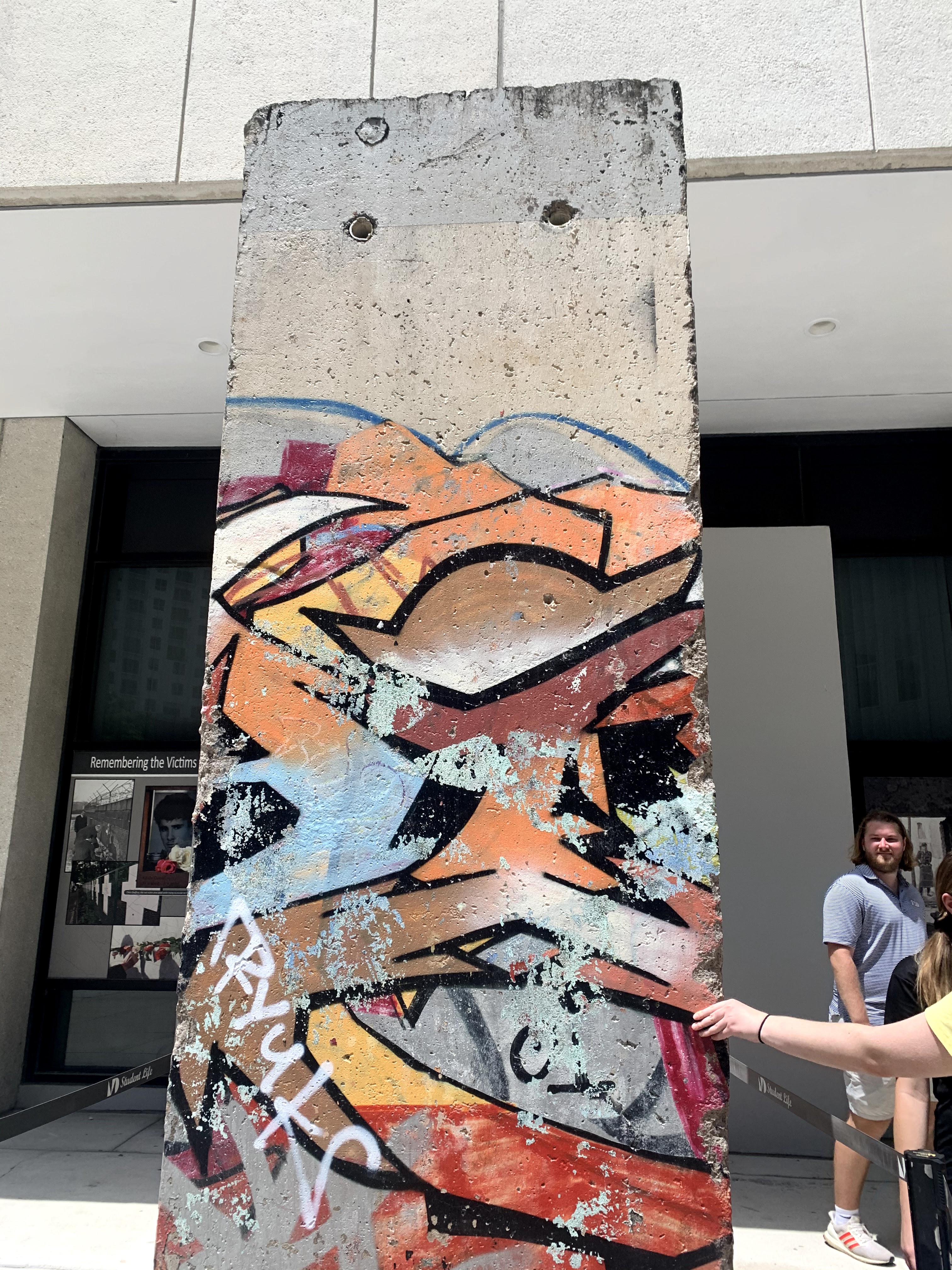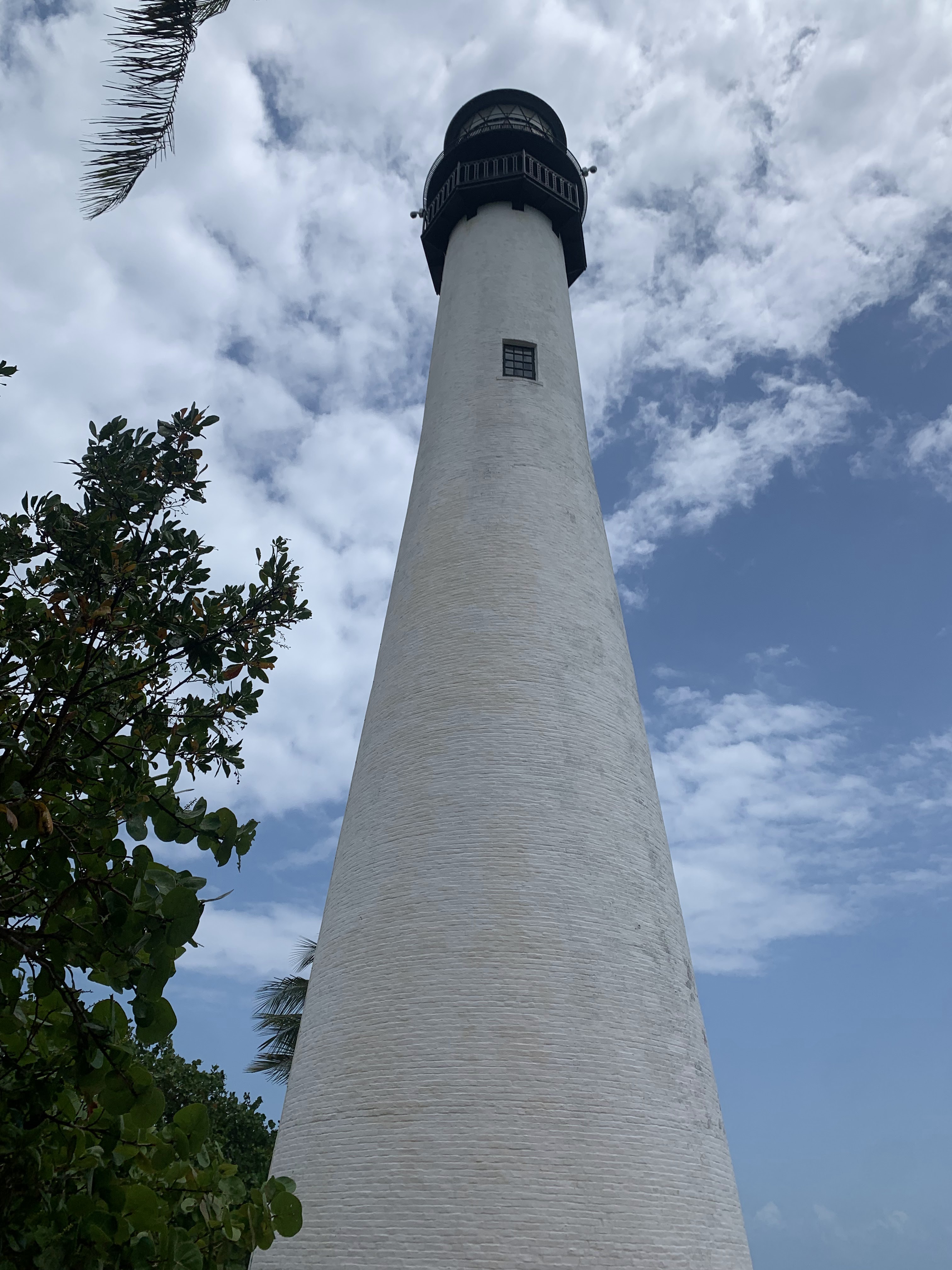
Luis Gutierrez is currently a sophomore studying English at Florida International University. He loves to watch movies, listen to old music, and play beach volleyball with his friends. He also enjoys writing and collecting vinyl records.
Downtown as Text

“The Wall that Needed to Fall”
By Luis Gutierrez of FIU at Downtown Miami, Florida, 13 September 2021
Downtown Miami, Florida is known for capturing many famous and iconic scenes of our world’s history. From statues to monuments, to houses and museums, everywhere you turn there is an opportunity to catch a glimpse into the past. One of these opportunities resides on 3rd street, right outside one of the campuses for Miami Dade College. Though many pass by this graffitied piece of cement, once you are informed, the power and importance it holds is breathtaking.
This piece of cement was a portion of the Berlin Wall before its collapse in the late 80s. The Berlin Wall was placed to divide East Berlin from West Berlin and to stop emigrants from crossing freely. This separated families and friends instantly and soon caused riots around the wall to appear. Residents, desperate to get over the wall, would jump from the surrounding houses and even create makeshift hot air balloons. Eventually, in 1989, the leaders of East Berlin announced that the wall and its power will be stripped away, and all residents are free to cross the border. To celebrate, people would bring tools such as pickaxes and anything they had to tear down this concrete border that divided their people.
This portion of the wall now serves as a reminder of what those people experienced for over 20 years. The thought of being divided from my friends and family for even a couple months sends a shiver down my spine so I cannot imagine the thoughts and emotions the residents of Berlin were experiencing. This should also serve as a reminder of all the abstract walls that are now built up today and how they divide us as both a nation and as a species. Though we cannot see these walls, they nonetheless are serving the same purpose of dividing us and making our people weaker. We must come together as a people and strike down these walls that surround us.
Overtown as Text

“The Showcase in Overtown”
By Luis Gutierrez of FIU at Overtown, Miami, Florida, 26 September 2021
Overtown contains many historical landmarks that showcase the history of Miami’s community. Specifically, the black community that added a massive chunk to the foundation of what Miami is today is showcase in several locations around town. One of these locations happens to be The Historic Lyric Theater that proudly stands as a Historic Place on Second Avenue.
The theater was home to many performances and gatherings in the late 1920s up until the 1960s. It was a hotspot for tourists, Miami residents, and especially the black community. Along with being a home for entertainment, this building also served as a gathering place for schools, civic groups, and other special events. It also served as a movie theater and later a church. Unfortunately, as time went by and this part of Miami became forgotten, the theater was boarded up and closed for years and years.
Although closed in the 60s, The Historic Lyric Theater is now protected and lies on the list of National Registered Historic Places. This means that it has been restored and will continue to be restored along with being protected from any modern installations or companies. This building now serves as a representation of what life was back then for this community and now continues to represent the beautiful culture of Overtown.
Vizcaya as Text
South Beach as Text

“Out with the Old and In with the New…or Maybe Just a Bit of Both?“
By Luis Gutierrez of FIU at South Beach, Miami, Florida, 3 November 2021
South Beach, Miami, Florida holds a lot of Miami’s history as well as our state’s history that can be seen in many landmarks and buildings. Many of these buildings unfortunately were remodeled to fit today’s standards and be as advantageous for big employers. Though some were remolded over the years, some remain intact as either a historical site, museum, and even commercial property. Commercial property? How can a building that is over 30 years old be used for commercial property?
A great example to this question is the Lincoln Theater. This place of cinema was popular around the 1940’s and housed many performances, shows, and films. It was a hotspot for the people of South Beach and even tourists from around the globe. Unfortunately, it was closed in around 1980 but was then later bought by New World Symphony in 1990. Later, in 2012, H&M signed a contract that allowed them to transition the interior into a retail store for their company but were required to keep a lot of the art deco and theater elements intact. Now, it is still home for H&M customers yet it still carries the aura of its previous utilization of being the Lincoln Theater.
The Lincoln Theater isn’t the only location that something similar has happened to them. Around South Beach, there are a handful of buildings, especially on Ocean Drive, that contain original architectural elements with having a restored, modern approach in the interior. This technique of revitalization yet keeping the style of its predecessors is one that should be seen more often. Many buildings have just completely been scrapped and turned into a skyscraper or a parking lot. Though there are regulations now that protect certain buildings, one of South Beach’s top priorities should be keeping their roots and history alive through their buildings.
Deering as Text

“The Secret Stash”
By Luis Gutierrez of FIU at the Deering Estate, 10 November 2021
The Deering Estate is a marvelous place and contains a whole story that is significantly connected to Miami’s history. From Tequesta Burial Mounds to a preserved stone house, the Deering Estate has something for everyone. In this stone house that Deering had built in 1922, there are tons of rooms that showcase a bit of history through the pieces of furniture and the architectural designs. Though there are many rooms to explore, one room was found later in history when it was bought from the Deering family.
This room, as shown above, was a wine cellar. Now, this wasn’t an ordinary wine cellar. This one was hidden behind a bookcase and a massive vault door. When the new owners found this door, they asked the Deerings if they had known anything about it and they responded with, “A vault in the basement?”. This was one for the books and it required a master locksmith to break into it after several days. Once it was open, they found hundreds of broken bottles due to damage from storms and the hurricane at the time.
What is interesting about this wine cellar is that why would it be hidden? There are many theories out there that question it but the one I personally believe is that it was hidden because of the Prohibition. And so this became a side hustle for Deering to export and import wine and then store them in his basement. Whatever the truth is, the Deering Estate and house holds a historical tie to it predecessors. With estates and museums such as this place, we are fortunate enough to take a glimpse into the past. These locations should be preserved and promoted in every way.
Rubell as Text

“We are Frozen”
by Luis Gutierrez of FIU at Rubell Art Museum, Miami, Florida, 24 November 2021
The Rubell Art Museum is a great place to find art pieces that exhibit emotion, history, and the essence of humans. It has several floors that contain totally different pieces that all are different expressions of art. Some stand out in color and size while others stand out in meaning and detail. Regardless, every work of art shown in the museum is magnificent and should be paid attention to greatly.
One of the pieces of art is “Men Trapped in Ice” by Robert Longo. This artwork was done in 1979 in New York and was created from a dream that Robert had. This dream was of many men that had their feet frozen in ice and that they could only move from their ankles up. The artwork depicts these men being in torment while their feet are frozen. And also, since it is a two-dimensional piece of art, they are frozen from the ankles up as well. Robert also added that he wanted the men to be in punk/ rock and roll uniform so that they follow a sort of rhythm within the paintings.
This artwork stood out to me because it looked as if the men were dancing like the main singer from the band Joy Division, Ian Curtis would dance. Though with further inspection, the piece of art was nothing like the idea I had formulated in my head. But this process of seeing what the painting or work of art meant to me and then reading what the artist had intended was very interesting. Art should be interpreted by the viewer in any way they want or imagine before seeing what meaning is behind the art, if there even is one to begin with.
Everglades as Text

“In the Heart of the Everglades” by Luis Gutierrez of FIU at Everglades, Miami, Florida 30 January 2022
One of Miami’s most interesting and distinguishable places is the Everglades. This national park is the largest subtropical wilderness in the United States and has both a wet and dry season. It has several different fauna that can easily be seen in the ground as well as floating in the water. The beauty of the Everglades is that, once completely immersed, you can see nature fully, without one man-made structure in sight.
I have been to the Everglades several times through the class I am taking through the Honors College known as Miami in Miami with Professor Bailly. In all the times, our class was fortunate to have a park ranger to guide us and give us information regarding the ecosystem and the Everglades as a whole. Every visit is a different and memorable experience that leaves me a changed person for the better. An excursion in nature is one that I would recommend to anyone, regardless if you live in Miami or not.
Coral Gables as Text

“Ghosts Roam the Halls You Now Walk ”
By: Luis Gutierrez of FIU at Coral Gables, Miami, Florida, 13 February 2022
Coral Gables located in Miami, Florida contains an abundance of history that can easily be seen in its architecture. One of the most famous pieces of history is the Biltmore Hotel that is now on the U.S National Register of Historic Places. Whether it’s for a gala, a sports event, or a weekend vacation, this beautiful hotel is a complete luxury for whoever stays at it. After WW2, it was a bed hospital that aided injured soldiers in the Army. Much of the building became covered with concrete such as the walls and flooring of the hotel. Coral Gables became the new owners in 1973 and slowly restored it to its now astonishing beauty. The restoration process was lengthy but much of the décor was preserved due to the Army covering much of the building with concrete. Today, it grants visitors an amazing experience that they will never forget.
Included with its long history are a few tragic and even shocking events. One in particular involved a shooting of a big time mobster in a speak easy. Another involved a woman jumping from a high floor to save her child and unfortunately fell to her death. These and several other deaths add to the hotel’s rumor of it being haunted. Many shows have taken place here to debunk the theory of it being haunted. If it is haunted, why do people still spend the night? Do they not know that the rooms they sleep in might already be occupied by a former resident? Whichever the case, the Biltmore still stays being one of the most luxurious places to stay at in Miami, Florida.
River of Grass as Text
Design District or Wynwood as Text

“Tower of Faults” by Luis Gutierrez of FIU at Margulies Collection in Miami, Florida, March 20 2022
The Margulies Collection located in Miami, Florida is a great place to witness works of art that each hold a unique weight. Whether this is emotional, historical, or physical weight, each piece affects the viewer differently. In one case, the weight of an art work is both in its physical and emotional attributes. The piece I am referring to is “Die Erdzeitalter” or Ages Of The World. When walking into the room that contains this art work, a sudden weight is put on your eyes and shoulders. It’s presence in the room diminishes any sound or sight and fully takes hold of your attention until you leave the room. In order to fully view it, you must walk around it completely and take it all in through several perspectives, angles, and levels.
“Die Erdzeitaler” is the culmination of canvases, rocks, photographs, and other elements that come together to form a disfigured mountain that closely resembles rock sculptures that are placed in hiking trails. To me, this piece resembles a tower that is made up of mistakes, faults, and regrets. It is the product of all the never said goodbyes, the chances and opportunities that were never taken, the last hug that you didn’t know was going to be the last one. It is a large tower of all of those things and soon, after a couple more pieces are added on to it, a couple more moments added to the tower, it will collapse and fall piece by piece. I believe this piece serves as a reminder to check on your loved ones and those who surround you, because you never really know how tall their tower is.
Coconut Grove as Text

“Ageless Playhouse” By Luis Gutierrez of FIU at Coconut Grovve, Miami, Florida 4 April 2022
Coconut Grove, Miami, Florida contains an assortment of houses and buildings that give residents a glimpse of what Miami used to look like in its past years. One of the buildings that gives this unique glimpse is the Coconut Grove Playhouse. It was constructed as a movie theater and opened in 1927. It was home to a variety of movies and plays through the course of its lifetime until it unfortunately closed in 2006. Though its abandonment and closure, it eventually landed a spot on the National Register of Historic Places some years later in 2018. There are rumors of renovation and potential opportunities of reopening it in the future throughout the community and county commissioners.
The Coconut Grove Playhouse is an example of what Miami’s architecture should be revolved and focused on. Though cities and corporations always tend to put innovation and profit as their main priority, small buildings such as this one should have a say in how the area around them is kept. A house on the same block is also a historical house and yet it is being kept in such a poor condition and is not being up-kept at all. There should be a shift of focus in regards to reopening this playhouse to not only gain profit, but to more importantly, keep one of the few pieces of Coconut Grove history alive and well kept.
Key Biscayne as Text

“The Resilient Lighthouse” by Luis Gutierrez of FIU at Key Biscayne in Miami, Florida, April 6 2022
Bill Bags Cape Florida State Park is a great vacation spot that has access to many learning opportunities as well as a renowned beach for visitors to enjoy. In this park, there are several historical landmarks as well as several historical artifacts dispersed around. One of the historical landmarks is a lighthouse that can easily be seen from the shoreline or the long pathway that leads up to it. Located next to it, is the lighthouse keeper’s cabin that would be the home for the person who would keep the lighthouse operational. Both landmarks can be entered by the public (only on specific days that the rangers allow the public to enter) and is an experience every person should have.
The Cape Florida Lighthouse is the oldest structure in Miami Dade due to it dating back to having been built in 1825. It is also fortunately on the National Register of Historic Places so it can be protected from any future construction or renovation. This tall, sleek monument containing over a hundred spiral steps has gone through a lot of events and turmoil such as hurricanes and even a Seminole attack that severely damaged the tower. Fortunately, it was rebuilt in 1846 it still stands proudly today as a beacon of resilience not only for sailors but for admirers of history as well.